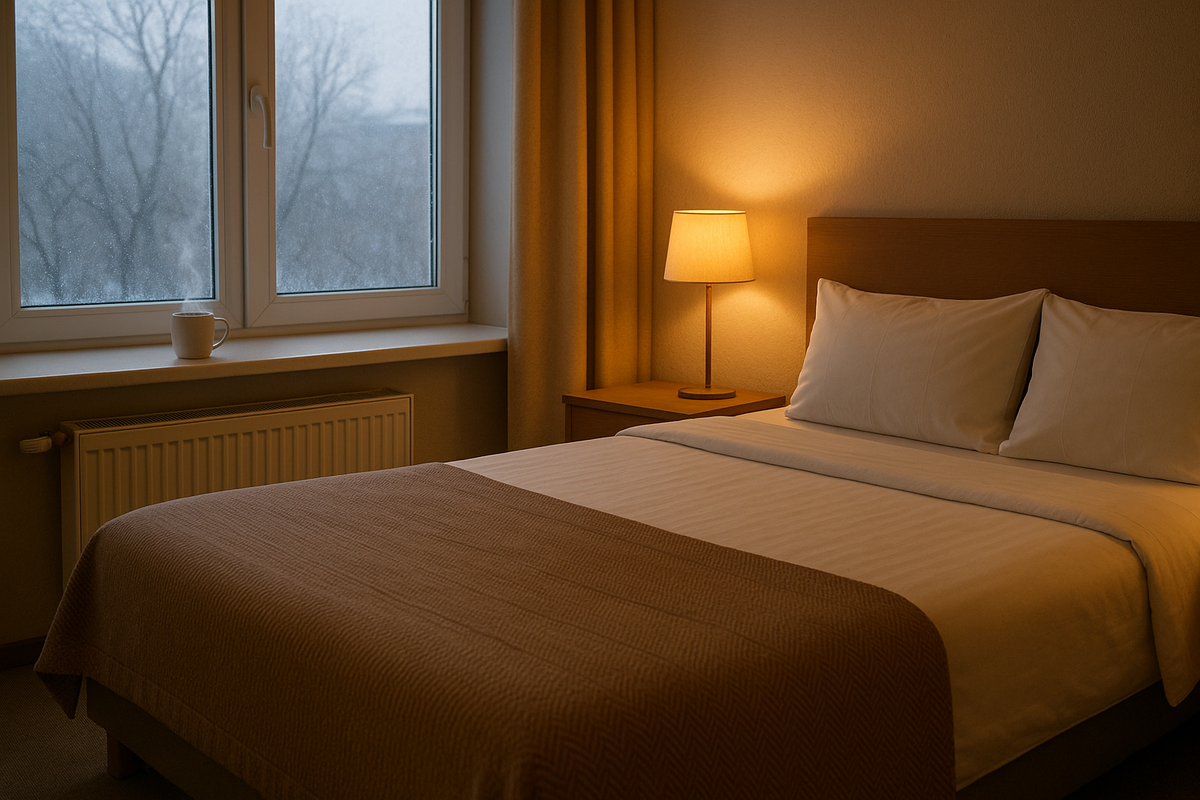❄️Three days in winter in the city centre: how to choose a warm and quiet hotel
You don't enter Copenhagen in winter through a postcard with Nyhavn, but through silence: it's still dark, the tram lights from the metro, steam from your breath and the occasional window where candles are already burning. Three days in such a capital can cost several times less than in July, but one wrong decision about a hotel — and you will freeze, wake up from the noise or run around the city in search of an early breakfast.
This article is about how to choose a warm and quiet hotel for 3 winter days in the centre to take advantage of the low season rather than suffer from it.
❄️ Why winter in Denmark is a profitable but ‘capricious’ time
- According to major aggregators, January–February are the cheapest months for hotels in Copenhagen: Kayak and Skyscanner record the lowest average rates in January, and Expedia separately notes that it is cheapest to stay in January–February and October.
- Reddit discussions among local hoteliers confirm that January and February are always ‘slow’, plus sometimes April and November.
This means that in winter, you pay less for the same location and the same room. The downside is short days, dampness, wind, and the fact that any miscalculations in terms of warmth and logistics are felt more strongly.
🔦 Light Festival: the main bonus of a winter trip
From 31 January to 23 February 2025, the city will host the Copenhagen Light Festival — dozens of light installations from Nordhavn to Ørestad, along the harbour and in the centre.
Why this is important for choosing a hotel:
- you will be walking a lot in the evening along the illuminated routes → it is convenient to stay in the centre or on the M3/M4 metro ring, rather than travelling from somewhere in the suburbs;
- the winter cold is compensated by the fact that you return to a warm room or a hotel with a sauna/spa, rather than just ‘another budget room’.

🚇 Location: how “central” should the centre be
In winter, it's not just ‘pretty streets’ that are important, but also:
- 5-10 minutes to the underground: Copenhagen's metro+train from the airport to the centre takes less than 15 minutes, and the underground runs 24/7; at night, the interval is longer, but you can get from your flight to your hotel or from the light festival to your room at any time.
- Minimum transfers: the less time you spend standing in windy passageways, the better. Ideally, one metro line to the airport and a maximum of one transfer to the main points of the programme.
The best areas for ‘three winter days’:
- Indre By (centre) — if you want to live ‘inside’ the Light Festival routes and the Christmas/winter atmosphere.
- Vesterbro / near the train station — convenient for trains and the M3 metro, but be aware of the noise.
- Østerbro / Nordhavn / Frederiksberg — if you want a more peaceful night's sleep, but are willing to travel 10-15 minutes to the centre on the Cityringen.

🔥 Warmth and quiet: a checklist for room descriptions
1. Heating and temperature control
Hotel descriptions rarely say ‘it's cold here,’ so we focus on indirect signs:
- Danish hotels most often have radiators with thermostats + sometimes warm floors in the bathroom;
- read recent reviews (especially for January–February): the words ‘cold room’, “draft”, ‘heating’ will tell you a lot about the real situation;
- don't be afraid to write to the hotel in advance and ask if there is a possibility of an extra blanket/heater — in winter this is a normal request, not a strange one.

2. Early breakfast
In winter, many excursions and trips start early. The chains have specific time slots:
- Wakeup Copenhagen:
- Mon–Fri: 6:30–10:00,
- Sat–Sun and holidays: 7:00–10:30.
- CABINN City/Copenhagen:
- Mon–Fri: 6:30–10:00,
- Sat–Sun: 7:30–10:30; price ~110–125 DKK when booked in advance.
If you have a morning train or early excursion, it is better to choose a chain with a clear early breakfast rather than a café that ‘opens around eight.’

3. Soundproofing
In winter, windows are more often closed, but that doesn't mean noise isn't important:
- choose rooms facing the courtyard or on the upper floors in areas with bars (Vesterbro, around Tivoli, Nyhavn);
- look for words like ‘soundproof windows’ in the description, but always check the reviews — they are more honest.
🧖 Hotels with saunas and spas: when warmth is part of the programme
In winter, hotels where you can literally warm up after a walk are especially appreciated:
- Hotel Kong Arthur (near the lakes, close to Nørreport) — a small spa centre Ni'mat with a sauna and relaxing treatments; often featured among the best city spas in Copenhagen.
- Tivoli Hotel & Congress Centre — indoor pool, sauna; convenient if you want to be close to Tivoli and the train station.
- Bryggen Guldsmeden / Axel Guldsmeden — boutique hotels with a warm ‘Scandi’ aesthetic and wellness areas (sauna, sometimes small pools or plunge pools).
- 1 Hotel Copenhagen (new eco-luxury by the water) — Bamford Wellness Spa with a focus on holistic treatments and natural cosmetics.
For a three-day trip, here's a good plan:
Spend 1–2 evenings at the spa/sauna instead of looking for a separate day of relaxation outside the city. This saves both time and money.

🧳 Examples of ‘3 days in winter’ scenarios
🕯 Scenario 1. Budget + warmth
- Where to stay: Wakeup or CABINN in the centre/near the train station — warm, compact rooms, early breakfast, walking distance to the metro.
- What to look for:
- ask for a room away from the lifts/street;
- bring warm socks/pyjamas — the rooms are minimalist.
Suitable if you want the most of the city for the least amount of money and are ready to warm up in cafés and at the light festival.
🌿 Scenario 2. Quiet comfort + centre
- Where to stay: a hotel in Østerbro/Frederiksberg or a cosy boutique hotel in the central side streets (not on the main bar streets).
- Special feature: 10-15 minutes to the centre on the M3, but with quiet streets and parks near the hotel; you can walk around during the day and return to your ‘home’ area in the evening.
🧖 Scenario 3. ‘Warm winter’ with spa
- Where to stay: Kong Arthur, Tivoli Hotel, Guldsmeden, 1 Hotel or another hotel with a sauna/swimming pool.
- Format:
- morning: early breakfast and walks/museums;
- day: Light Festival/canals;
- evening: an hour and a half in the sauna/spa area.
Three such evenings give the feeling of a mini-sanatorium in the city.
❓ FAQ
This does happen, but it is the exception rather than the rule. Rooms usually have radiators with thermostats, and sometimes there is underfloor heating in the bathroom. More often than not, people complain not about the lack of heating, but about draughts from old windows or the fact that the staff skimp on the temperature. Therefore, it is important to read recent reviews for January–February and immediately mention if you feel cold when you check in: normal hotels will provide an extra blanket or raise the temperature slightly without any problems.
The minimum ‘winter set’ for a hotel: warm socks/slippers for the room; a light house jacket/fleece to wear over your pyjamas; if desired, a thin thermal jacket that you can wear for walking and sleeping; a small thermos for tea/coffee in the evening. This greatly increases comfort, even if the hotel itself is warm.
It's not essential, but it's very nice. For a short 3-day trip, a spa hotel makes sense if: you enjoy such treatments and will definitely use them; the trip is more about slowing down and warming up than ‘driving’ yourself 20 km a day. If your budget is limited, you can take one evening at a city bath/spa and stay in a simpler hotel rather than overpaying for three nights for a wellness area that you will never get around to using.
The metro and trains run around the clock, and the journey from the centre to the airport takes about 12-15 minutes, so in most cases it is more convenient to stay in the centre: you don't miss out on the city's atmosphere in the evening, and in the morning you can calmly get to the terminal. A hotel near the airport only makes sense if you arrive/depart late at night and don't want to think about the journey at all.
If you are travelling in January–February, when it is dark and damp, breakfast at the hotel becomes a noticeable plus: you don't have to look for an open café at 7 a.m.; you can sit quietly, wait for dawn and plan your day. Chain hotels such as Wakeup and CABINN serve breakfast from 6:30 a.m. on weekdays, which is convenient for early departures. If you have a relaxed schedule and enjoy exploring local bakeries, you can skip breakfast, but then you'll need to factor in time and budget for cafés.
If your budget allows, Indre By: minimal travel, the Light Festival takes place right outside your window, and all the cafés and museums are nearby. If peace and quiet and reasonable prices are more important, Østerbro, Frederiksberg or Nordhavn: they are quieter, but you can get to the centre in 10-15 minutes via the M3/M4 ring road and return to your ‘cosy’ neighbourhood.
For Copenhagen, the answer is almost always ‘no.’ Parking in the centre is expensive, the rules are complicated, and public transport works perfectly well in winter and at night. It's easier to stay closer to the metro and use the 24/7 metro + trains than to pay for parking and stress about signs and fines.





0 comments
Log in to leave a comment